When you come to think of it that is the secret of most of the great holes all over the world. They all have some kind of a twist. C.B. MACDONALD
Old Tom Portraits Found, Going On Display
/"ST ANDREWS TO HOST 2015 OPEN CHAMPIONSHIP"
/For Immediate Release:
ST ANDREWS TO HOST 2015 OPEN CHAMPIONSHIP
11 October 2011, St Andrews, Scotland: The Open will return to the Home of Golf in 2015 when the 144th Championship is played at St Andrews from 16-19 July.
It will be the 29th time that golf’s oldest Major has been held over the Old Course.
South Africa’s Louis Oosthuizen won by seven shots with a 16-under par total of 272 when The Open was last held at St Andrews in 2010.
The R&A’s Chief Executive Peter Dawson said: “We are delighted to announce that The Open will be returning to St Andrews and the historic Old Course in 2015.
“St Andrews has proved time and again that it is perfectly equipped to host The Open and I am certain we will yet again see a worthy winner lift the Claret Jug.
“Players, spectators and officials alike will welcome a return to the game’s spiritual home and I fully expect that we will witness another thrilling Championship.”
Euan Loudon, Chief Executive of St Andrews Links Trust, said: “We are very much looking forward to welcoming The Open Championship back to the Links.
“There is always a special sense of anticipation when The Open is played on the Old Course and it promises to be no different in 2015.
“Almost every great champion in the game has played here and there is no more fitting celebration of the rich heritage of the Home of Golf than hosting golf’s oldest Major Championship.”
In the course of its 28 Opens, St Andrews has often produced Champions who are the best of their generation. Tiger Woods won by eight and five shots in 2000 and 2005 respectively, joining past winners that include J. H. Taylor (1895, 1900), James Braid (1905, 10), Bobby Jones (1927), Peter Thomson (1955), Bobby Locke (1957), Jack Nicklaus (1970, 78), Seve Ballesteros (1984) and Sir Nick Faldo (1990).
DVR Alert: First Wheelchair Golfer To Play Old Course
/7 ET Tuesday on ESPN's E60. The story:
After Mike Reeder lost both legs in Vietnam, he returned to the U.S. looking for purpose and direction – and found them during a chance encounter in a golf pro shop. Years later, as a devoted golfer, he’s chasing a different dream: to be the first wheelchair golfer to play the Old Course at St. Andrew’s. E:60 follows him to Scotland.
The preview:
World's Most Famous Course To Get Its Very Own Luxury Apartments; Duke's Course Tee Times Thrown In To Seal Deal!
/ Start saving up, the Hamilton Hall Grand will be providing all of the amenities for select mega-wealthy folks to look down on the Home hole at St. Andrews. Kohler plumbing included!
Start saving up, the Hamilton Hall Grand will be providing all of the amenities for select mega-wealthy folks to look down on the Home hole at St. Andrews. Kohler plumbing included!
Our goal is to restore Hamilton Grand and create a dwelling that will make the people of St. Andrews proud, said Debbie Taylor, President Hospitality and Real Estate Group, Kohler Co. We have been honored to work with community members throughout this process. With their support, we are pleased to unveil our plans to the rest of the world.
Hamilton Grand will offer a total of 26 private residences ranging from two-, three- and four-bedroom apartments, including a penthouse with expansive 360-degree views and a private balcony. Residents will experience award-winning hospitality with butler service, valet parking and a golf concierge.
It's a job creator!
Hamilton Grand will also feature a Grill Restaurant and Bar, open to the public, and a Members Library on the ground floor. For an added premium, a private chef and sommelier is available to cook in the comfort of resident s apartments. Residents will have exclusive membership of The Duke s Course, Kohler Waters Spa and all the amenities of the Old Course Hotel including 4 distinct dining experiences.
Featuring unparalleled views of the Old Course, The West Sands Beach and the Bay of St. Andrews, the residences are available unfurnished or fully furnished with handcrafted furniture from Baker, a Kohler-owned company. Signature KOHLER plumbing products will be included in each residence.
Hamilton Grand will be a unique real estate opportunity for those who want to own a home in the birthplace of golf and a premier destination that is rich in history the holy grail of golf, said Taylor. We are looking forward to restoring the building using our restoration expertise, and returning a piece of Scottish history to its landmark status.
Golf As It Should Be Files: Kingarrock
/Nearly two years ago I vowed to profile more of the great, perhaps unsung places in golf and I've failed miserably since that initial post on Santa Anita Golf Course.
But with the holidays looming and the news drying up, it's a nice time to highlight a very special place. It's been an amazing year for me, with stops in Pebble Beach, St. Andrews, Churchill Downs and many other great spots, yet no day brings back fonder memories than a late afternoon round at Kingarrock.
I Guess This Rules Out Herb Kohler Buying A Ryder Cup For St. Andrews
/Third Open Championship Question: Could The R&A Get More Out Of The Old Course?
/Okay the Open coverage will be winding down, but another question that's been on my mind involves the topic of course setup.
In my piece for Golf World summing up the Old Course's week, I get into the unnecessary rough throughout the course that eliminates key areas needed to attack certain hole locations. It appears to be a product of three things:
-Someone intentionally narrowing the place down
-Overall overwatering, leading to overspray unintentionally hitting native roughs
-Subtle mowing pattern changes over time
Because of space considerations, I also just mention but not detail the combination of some really edgy hole locations with redundancy of placements over the four days on some holes. The R&A theory on keeping holes bunched in small areas is due to the double greens and the desire to keep players moving. However, even with this situation carried out as planned, players still wait for their peers on the neighboring green.
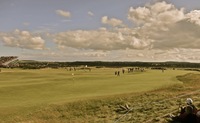 The 7th (left) and (11th). Imagine swapping the hole locations one day to give players a fresh look? (Click to enlarge)So with that in mind, I'm wondering if the R&A is really getting the most out of the Old Course with their setup? This year things were not helped by a consistent wind direction over four days, but why not throw so major twists into the setup? Say, play the seventh hole to the eleventh green area and move eleven down nearer the seventh (this would require moving the scoreboard).
The 7th (left) and (11th). Imagine swapping the hole locations one day to give players a fresh look? (Click to enlarge)So with that in mind, I'm wondering if the R&A is really getting the most out of the Old Course with their setup? This year things were not helped by a consistent wind direction over four days, but why not throw so major twists into the setup? Say, play the seventh hole to the eleventh green area and move eleven down nearer the seventh (this would require moving the scoreboard).
Or perhaps play the second hole to the sixteenth green one day and the sixteenth to the second? In other words, maximize the looks that players get over four days? After all, if there's any place you should be doing varied day-to-day setup, isn't the Old Course the one?
I did see one stellar mixing up move, when the 5th was played up front all three days, usually 12 to 15 paces from the front. Sunday, the hole was cut 85 paces deep into the green!
So should the R&A do more of that or would players and media howl when they fail to use the "traditional" hole locations?
Gigapan And Time Elapse-Video Of The Home Hole
/Darren Carroll's Gigapan shot of the Home hole is up and while it's spectacular, I can't help but wonder how fun it would be to put one of these cameras up on a crane and shoot down on the Old Course's key holes so that we could zoom in and study the features.
Golf.com offers an alternative in the form of time-elapsed video. As great as it is, I think it'd be more fun to have one of these in the media lunch room to watch us scribes work the free buffet provided by the R&A (and it was quite good too).
"I think it's a good thing for St. Andrews so long as it does not stifle progress. I would want to be very satisfied that that was the case before being a supporter of it."
/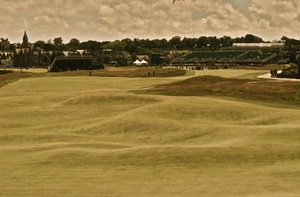 The sacred contours of the second hole should be protected from "progress." (Click to enlarge)Lost in the R&A press conference talk over changing the Old Course boundaries, the last minute rough mowing and the overall jaw dropping wackiness that is a the R&A trying to set up their home links course, was a question and Peter Dawson answer in today's presser. Steve Elling reports:
The sacred contours of the second hole should be protected from "progress." (Click to enlarge)Lost in the R&A press conference talk over changing the Old Course boundaries, the last minute rough mowing and the overall jaw dropping wackiness that is a the R&A trying to set up their home links course, was a question and Peter Dawson answer in today's presser. Steve Elling reports:
The Old Course has reportedly been listed as a nomination candidate for World Heritage status, a program run by the United Nations to help ensure that cultural icons remain protected, if not unmolested, for enjoyment by future generations.
Sounds like a perfect match for the so-called Home of Golf, yet Dawson said he only conditionally supported the notion -- providing that it must still allow some wiggle room for further R&A tinkering.
"I think it's a good thing for St. Andrews so long as it does not stifle progress," Dawson said. "I would want to be very satisfied that that was the case before being a supporter of it."
Of course, his definition of progress is a lot different than the way others see it!
R&A Returns Old To Four Off-Course Tees Instead Of Five!
/"It doesn't add a huge amount to the second shot. It adds a lot to the tee shot."****
/"It's unfortunate because you're trying to get drama. It's a TV sport. The 17th has given them some great drama over the years. The change nearly has the opposite effect."
/ I'm sure we'll all be exhausted by the Road hole talk this week, especially since most centers on the new tee and not the narrowness of the landing area. But in reading Mark Reason's account, it's still a wonderful topic because of the golf-ball-goes-too-far element going mainstream in prominent UK papers like the Telegraph. (See post below.)
I'm sure we'll all be exhausted by the Road hole talk this week, especially since most centers on the new tee and not the narrowness of the landing area. But in reading Mark Reason's account, it's still a wonderful topic because of the golf-ball-goes-too-far element going mainstream in prominent UK papers like the Telegraph. (See post below.)
Also interesting is Graeme McDowell's view that many players will play the hole more conservatively and therefore have the opposite effect of the R&A's intent.
Players like McDowell have also warned that much of this week's field will now be more conservative and lay up to the front right edge of the green. They fear 'The sands of Nakajima' to the left or the path and wall to the right.
McDowell said: " It's unfortunate because you're trying to get drama. It's a TV sport. The 17th has given them some great drama over the years. The change nearly has the opposite effect. It's certainly a pretty significant change."
The R&A argues that if Tom Watson had the bottle to hit a 2-iron in his iconic battle against Seve Ballesteros in 1984, then the modern golfer should be able to cope with a 4-iron. Peter Dawson, the R&A chief executive, points out that the hole's length had not changed since 1900 and that players were coming in with very short irons.
The R&A hope that the extra length will force players to use a driver off the tee and a mid to long iron coming in. That will increase the risks of mistakes and bring the hazards more into play, particularly the infamous Road Hole bunker, nicknamed 'the sands of Nakajima' after the Japanese player who took five shots to get out.
Andrew Coltart was even more eloquent on the topic in a Scotland on Sunday piece by Paul Forsyth.
Andrew Coltart is another who fears that rolling back the years will lead to more conservative, even boring golf for the galleries. "I'm not sure it's going to be harder. In a way, it's going to be easier because you are going in there with a longer club. Part of the difficulty before was the temptation to go for a tight pin tucked behind the bunker. Now, if you're going in with a 4 or 5-iron instead of a 9-iron or wedge, that temptation is gone. You're just going to play short and right, and run it up the slope. You're going to see fewer guys in the bunker."
Coltart, who came through International Open Qualifying at Sunningdale, is rather a student of St Andrews. A member of the Scotland team that won the Dunhill Cup there in 1995, he loves the Old Course and everything it stands for. It has its faults - such as the pace of play, and the limited view it affords spectators - but the historic challenge it presents ought not to be tinkered with. "When Usain Bolt keeps breaking the 100-metre world record, they don't stick another couple of yards on his line to level it up. What's wrong with low scores? Let's make it attractive, make it exciting.""OK, things change, time moves on, but people still look at art in the same way they did before. They still marvel at them. They don't touch them up to go with the flow. They should have left the 17th as it was. It's a gorgeous golf course, a wonderful place to play, but if you start making changes, it's not the same golf course. It's not the one played by the legends whose footsteps you are trying to follow."
Q&A With Scott Macpherson, Part II
/No course has been more deserving of thorough analysis and a loving attention to the details of its evolution than the Old Course, and Scott Macpherson done it with St. Andrews: The Evolution Of The Old Course. He compiles rich anecdotes and lavishly illustrates this handsome tome to help us understand just how much the Old Course has evolved and more importantly, why it retains its brilliance.
In Part II of our Q&A on the eve of the 2010 Open Championship, he talks about specifics of the course and his own design work with Greg Turner.
GS: Tell us what you've seen in terms of the Road Hole's "fairway" width evolution. Did the fairway used to open up more toward the first green so that players could bail out but face a much more difficult approach?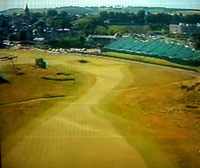 SM: Geoff, as you know, the term 'fairway' is a relatively modern term. But let's not get hung up on that semantic.
SM: Geoff, as you know, the term 'fairway' is a relatively modern term. But let's not get hung up on that semantic.
An article published around 1900's talked of the course in the 1850's and the course was described then as being "very narrow" with the fairways not any wider than "a good broad street". So traditionally there has not been a lot of width on the course. But as you know, with the greater amount of play, the course widened with all the wear from golfers. The grazing sheep (not taken off the course until 1945) also kept the rough grasses down, and kept the 'fairways' wide. But how wide did the 17th hole get? I'm not sure anyone knows, but I think it is safe to say that the corridor has changed over time. Only after the railway Station was built in the 1850's and Old Tom built the 1st green in 1870, and the bunkers down the left of the hole formalized, could it possible be said that the playing corridor was set.
It is probably important to say that with the road running along the back edge of the green, the best line into the green – especially if the flag is at the back, is from an angle that allows a golfer to hit down the length of the green. This is obviously from the far right. How far right could you get? Probably not much right of where you can get today due to the railway station. As regards the area around the green, this hole has only been a par 4 since (and including) the 1960 Open Championship. Few players back in the early 20th century would have got past the Scholar's bunker, so this was the more important area for many decades. Now with the hole being a Par 4 there is greater interest in the Road Hole bunker. (There is possibly too much interest in it actually appearance – it most important aspect is it position and the area from which it gathers balls)
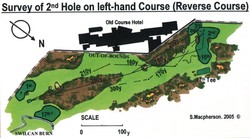 The 17th in reverse plays as the second hole (From St. Andrews: The Evolution of the Old Course, click image to enlarge)GS: The 17th in the reverse Old Course, which would be the second hole, is depicted in your book and the strategy looks fascinating assuming there's a bit more width. Do you know anyone who has played it?
The 17th in reverse plays as the second hole (From St. Andrews: The Evolution of the Old Course, click image to enlarge)GS: The 17th in the reverse Old Course, which would be the second hole, is depicted in your book and the strategy looks fascinating assuming there's a bit more width. Do you know anyone who has played it?
SM: I have played it many times. A few years ago, the Links Trust started allowing the 'reverse course' to be played in April. I think it was for a week at first. Now they do it every second year for about 2-3 days. The 17th in reverse is a tremendously difficult hole. Particularly the approach shot to the green. The hole becomes a real adventure, and it (and the 12th in reverse) are high-lights of the experience.
GS: You feature a graphic showing just how little square footage is actually pinnable on the Road Hole and Eden greens. Do you know actual square footages of pinnable green space on those holes? Scott Macpherson's slope percentage analysis of the Old Course's 11th green (From St. Andrews: The Evolution of the Old Course, click to enlarge)SM: When the greens are running over 10.5 on the stimpmeter, I think the for the 17th green, the pinnable area is just over 300m2. For the 11th, it is about half that – say 150m2. i.e not very much!
Scott Macpherson's slope percentage analysis of the Old Course's 11th green (From St. Andrews: The Evolution of the Old Course, click to enlarge)SM: When the greens are running over 10.5 on the stimpmeter, I think the for the 17th green, the pinnable area is just over 300m2. For the 11th, it is about half that – say 150m2. i.e not very much!
GS: You detail the issues with boundaries on the course, when did the right of the Home hole become out of bounds? Would you prefer it to have no boundary and to see a few shots off of the doorsteps of Tom Morris's golf shop?
SM: The Out-of-Bounds areas became such on the 17th of July 1911. It was mainly a practical solution I understand. I love the 18th hole because the golfers expect to make 3 on it, and yet this hole can provides scores from 2-6 quite easily. No change needed.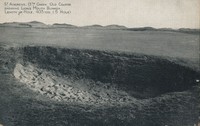 A hazardous bunker, Hole O'Cross, date unknown (Tournament play on the Corner Of The Dyke (Geoff Shackelford Collection, click to enlarge)GS: Which version/era of the Old Course would you most like to play and why?
A hazardous bunker, Hole O'Cross, date unknown (Tournament play on the Corner Of The Dyke (Geoff Shackelford Collection, click to enlarge)GS: Which version/era of the Old Course would you most like to play and why?
There have been some monumental periods in the evolution of the course. If one could time travel, of course it would be fascinating to see and play the course when it was 22 holes and then in about 1850 after the March stones had been put in the course was 18 holes and Halkett's bunker still existed on the 18th fairway. But if I was to choose one period I'd love to go back to 1904-05 and meet Old Tom, Horace Hutchinson, John Low, Garden G Smith, Harry Colt, understand the pressures on the Old Course (extra visitors, new haskell ball, new lawn mowers, Open Championship coming) that culminated in the addition of the 200 yards and extra 13 bunkers. This was a dynamic period – and I wonder how different the pressures where compared to where we were in 2005 with the Pro V1.
GS: They've added tees in some rather bold locations of late, but one thing we learn in your book is that bunkers have come and gone quite regularly until the last fifty or so years. Would you like to see something done besides tees?
SM: I celebrate the men, such as John Low, who have been at the centre of shaping the changes to the course while protecting its spirit. I don't underestimate the difficulty of this at any time, be it in 1900, or 2010, but I wonder if it would be more difficult today, now that millions more know, herald, and worship the Old Course. Having completed the research I see myself as a traditionist not a protectionist, and would like to see the Old Course add some more bunkers – and fill in a few of the obsolete ones – to keep the strategy of the golfing test at it's optimum. e.g. I would like to see the hollow just past the last of the beardies, and in the middle of the 14th fairway, made into a bunker. This would make the longer hitters have to hit the ball down a narrow corridor between the wall and this bunker to get as far down the fairway as possible. The bunker would be in keeping with the Beardies and improve the strategy of the hole.
 GS: Tell us about Close House and your design work there with Greg Turner.
GS: Tell us about Close House and your design work there with Greg Turner.
SM: Not many young architects are getting opportunities to design new courses these days so this project is a huge personal privilege to me. I was approached to design the course in 2004, and it took 5 years before we broke ground in April of 2009. The course is located on an old English mansion property near Newcastle, UK, complete with 200-year old oak trees, Ha-ha's and ancient monuments. I felt that the course needed a theme in keeping with the history of the property and suggested we build the course in the style of Harry Colt. the owner of the property owns many race horses so he liked the equine connection, and the course is to be called the 'Colt'. No two holes on the course follow in the same direction, the course is very strategic with a second shot being rewarded depending on the excellence of the first. The course is designed to look harder than it plays, with some holes having a small degree of mystery that will reward the regular player of the course. For a comparison, the course has almost 300 feet of elevation difference between the highest and lowest points – much like Pasatiempo – (and this is not a bad comparison on another level as Mackenzie use to work with Colt) but the highest point is on the 11th hole, so it is a all down hill to the Clubhouse from there. I am very excited about this course, and look forward to the opening in May/June 2011.











